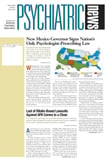Parents are more likely to initially raise mental health concerns about their children with pediatricians and other primary health care professionals than to seek out mental health specialists. Yet many primary care professionals are not trained to recognize the range of psychiatric problems that can arise. A new mental health practice guide from Bright Futures could boost their diagnostic skills and confidence in managing mental illnesses in children.
Bright Futures is a partnership between the federal Child and Maternal Health Bureau and the National Center for Education in Maternal and Child Health at Georgetown University. “Its federal mandate is to promote the health and well-being of children, families, and communities,” according to the Bright Futures practice guide.
The “Bright Futures Mental Health Practice Guide and Tool Kit” will be distributed to the more than 50 organizations that supported it, including the American Medical Association, American Academy of Child and Adolescent Psychiatry, American Academy of Pediatrics, American Academy of Family Physicians, and American Academy of Physician Assistants.
Previous Bright Futures guides have addressed oral health, physical activity, and nutrition. The guides emphasize interdisciplinary partnerships and partnerships between health professionals and families, schools, and communities.
The 371-page guide is divided into two main sections made up of chapters on child mental health development and common disorders among children and adolescents.
Michael Jellinek, M.D., chair of the panel of experts that produced the guide, said at a Bright Futures conference last month, “We wanted a practical guide that focused on how well the child functions individually, in the family, with friends, and in the community at each developmental stage.”
Each chapter is divided into the four areas of functioning that Jellinek noted and includes checklists at the end for health professionals to evaluate the child’s development.
The guide’s table of contents also lists helpful tools for health professionals and families under each developmental chapter. The tools are found in the companion Mental Health Tool Kit and can be photocopied for further distribution, such as to parents.
For example, under “Self-Esteem” in the chapter on early childhood, among the tools included for health professionals are “The Pediatric Intake Form” and for families are “Stimulating Environments,” “Safe, Quality Child Care,” and “Communicating With Children.”
Health care professionals can use the referral form in the tool kit to refer patients to mental health specialists. Another practical tool is a documentation form for reimbursement that can accompany insurance claims.
A National Agenda
The Bright Futures conference and new practice guide on children’s mental health build on the efforts of former Surgeon General David Satcher, M.D., to raise public awareness of mental disorders in adults and children. A specific goal mentioned in the national action agenda released last January that resulted from the 2000 Conference on Children’s Mental Health called for educating primary care providers and families to recognize the warning signs of mental illness in children (Psychiatric News, February 2, 2001).
More recently the Office of the Surgeon General (OSG) has been combining the children’s mental health goals and objectives with the recommendations from another report, “The Integration of Mental Health Services and Primary Health Care,” in the areas of practice, finance, and research, according to Eve Moscicki, senior advisor to the surgeon general and chair of the working group that developed the national action agenda on children’s mental health. When the results of that work will be released is not yet known, she said.
The OSG is also developing a set of early warning signs to identify when children need further mental health assessment or referral, as well as an initiative on mental health services in the schools, said Moscicki.
APA has long recognized that primary care professionals play a critical role in identifying psychiatric disorders in both adults and children. APA collaborated with primary care physician organizations to produce the DSM-IV-PC in 1995.
The American Academy of Pediatrics (AAP) launched a parallel effort with APA and the American Academy of Child and Adolescent Psychiatry and other organizations to produce the DSM-PC Child and Adolescent Version in 1996. The reasoning behind producing this volume was that children are cared for primarily by pediatricians and family practitioners and that clinicians encounter a wide range of psychosocial problems that may not meet full DSM-IV criteria for a diagnosis but still require intervention, according to the AAP.
The Bright Futures guide incorporates codes for mental disorders from APA’s DSM-IV-TR and codes for psychosocial problem from the DSM-PC Child and Adolescent Version.
Barriers Remain
According to Barbara Howard, M.D., a behavioral pediatrician and panelist at the Bright Futures conference, treatment reimbursement remains a problem.
“Insurance companies tend not to reimburse pediatricians who diagnose and treat disorders within the DSM 300 codes, including autism, depression, anxiety disorders, and attention-deficit/hyperactivity disorder. The AAP plans to undertake a state-by-state effort to talk to insurance companies about reversing that practice, starting with ADHD,” said Howard.
Kelleher told Psychiatric News that “most pediatricians believe they will lose money if they start diagnosing and treating mental health problems.”
Managed care has contributed to the problem by carving out mental health networks from primary care networks. “It is much harder for primary care professionals to be reimbursed for mental health services in carveouts than in integrated staff-model HMOs,” said Kelleher.
Moreover, primary care professionals spend an average of only 13 to 16 minutes with each patient, and each patient has an average of six problems to discuss, according to the OSG report titled “The Integration of Mental Health Services and Primary Health Care.”
Online Versions?
Howard and Kelleher have developed interactive computer systems for primary care settings incorporating some of the materials from the Bright Futures mental health guide. Howard’s system is known as the Child Health and Development Interactive System (CHADIS), and Kelleher’s is EnterVue.
Both claim that their online interactive versions are more efficient than the pencil-and-paper guides because they provide “real-time” information to clinicians and parents. Another advantage is they can be linked to patients’ electronic medical records, diagnostic codes, and Internet resources and used for research. These products are being tested and may be released late this year or next year.
The “Bright Futures Mental Health Practice Guide and Toolkit” are posted on the Web at www.brightfutures.org/mentalhealth/index.html. The two-volume set can be ordered at the Web site for $58 plus shipping and handling. ▪

